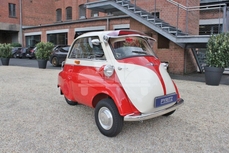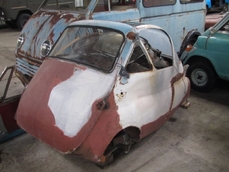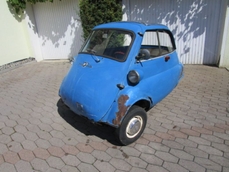BMW Isetta Coupe 1958
Allgemeine Beschreibung :
The BMW of today, with its tech-laden super-sedans, hybrid sports cars, and ultra-luxury SUVs would probably not exist if it weren’t for an Italian appliance company named Isothermos. The loose connection began in 1942 when by a young engineer and heir to an industrial fortune, Renzo Rivolta purchased Isothermos. With a passion for motoring, Rivolta began to expand the company’s range, adding motorbikes to the portfolio and renaming the works Iso Autoveicoli S.p.A. After World War II, Europeans were desperate to get back on wheels, but with raw materials and fuel at a premium, few could afford a conventional car. Motorbikes and scooters became hugely popular, but they were impractical in bad weather or for families. As a way to bridge the gap between bike and car, some manufacturers turned to motorbike-powered microcars that offered cheap, efficient, and practical transport for the masses.
Wanting to cash in on this new market, Renzo Rivolta began development of a 2-passenger microcar with a single front clamshell door, and a small capacity motorbike engine mounted amidships. Introduced in 1953, the Iso Isetta Turismo was the quintessential cheeky bubble car. It was adorable, it could transport two people and some groceries, and it was highly efficient, if not particularly quick thanks to having just 236cc and 9 ½ horsepower. It turned out to be reasonably successful in the home market, with 20,000 built at the Iso works in Milan.
Renzo Rivolta recognized a viable market for the Isetta; however, he lacked the manufacturing capacity to meet Europe-wide demand. Rivolta’s stroke of genius came in 1954 when he sold the rights to the design to several different companies in Europe and South America. Among those firms was BMW, who was struggling through the post-war recovery. Most of their factories were devastated by bombing, and their Eisenach works fell within Russian-controlled East Germany. BMW’s post-war product line consisted mainly of expensive six and eight-cylinder luxury cars that, while capable, had limited appeal in the post-war economy. Without the time and resources to develop a small car, the Isetta was the perfect opportunity to support the bottom line. Of course, they couldn’t help but to fettle with the design, modifying it to accept a 250 c.c. four-stroke engine shared with the R25/3 motorcycle and making minor styling changes. In 1956, BMW bumped the capacity to 298cc which gave the new Isetta 300 nearly one-and-a-half times the power output over the 250. With a storming 13 horsepower on tap, not even hills could stop BMW’s mighty-mouse! The Isetta continues to delight today’s collectors, and even the most serious collections make room for the adorable – yet historically significant – German bubble car.
This beautiful 1958 example is of the best sliding-window Isetta 300s we’ve had the pleasure to offer. It is meticulously restored and detailed to a very high standard, finished in the factory shade of Weisgold, code 106. The attention to detail is exemplary, particularly the quality of the bodywork and gorgeous paint. Excellent brightwork accents the lovely color scheme with the body equipped with optional bumper “over riders” as well as the integrated bumpers finished in exquisite chrome. The finishing touch is a set of wide whitewall tires on original steel wheels dressed with correct original BMW hubcaps. This car’s outstanding presentation makes it easy to see why BMW sold more than 160,000 examples of “the egg” and why it remains so beloved by enthusiasts around the world.
The cozy 2-place cockpit is restored to the same exacting standard as the exterior. Simple heavy-grain interior panels provide a modicum of sound insulation while a rubber mat lines the floor. Tan perforated vinyl covers the bench seat, with matching boots on the shifter and steering column. The bench is reasonably comfortable for two passengers, so long as both occupants are on speaking terms. The Isetta’s party piece is the single, front-mounted clamshell door. The steering column and dash cleverly swing out of the way on a series of universal joints allowing for easy ingress. Once situated behind the wheel, the Isetta is surprisingly airy thanks to the panoramic windshield and generous greenhouse. The fabric sunroof (fitted to every Isetta built) also helps, and it doubles as a secondary exit should the front door become blocked. Much like the body, the quality of the materials and finishing on the interior is first-rate. Original style labels and stickers are faithfully reproduced; particularly handy is the graphic showing the reverse layout for the four-speed shifter that sprouts from the body at the driver’s left hand. Factory-original switches and controls are restored to like-new condition.
It takes a short time to get used to driving an Isetta, but once comfortable; the experience is pure delight. The single-cylinder, 298cc 4-stroke engine is fizzy and full of character, providing enough power to buzz around town, while the ultra-short wheelbase and narrow rear track make it extremely maneuverable. This example runs very well, and the engine is appropriately detailed, looking exceptionally clean and factory correct beneath the side-mount engine cover.
The Isetta is a significant vehicle in BMW’s illustrious history. It allowed the company to survive during a difficult period, and it spawned the two-cylinder, rear-engine 700 series which gets the credit for rescuing BMW from a takeover attempt by Mercedes-Benz. This tiny car carried the weight of the company on its shoulders. Overflowing with charm and character, this Isetta 300 is a fabulous example and an essential addition to virtually any diverse collection.
https://hymanltd.com/vehicles/6485
1958 BMW Isetta Coupe is listed verkauft on ClassicDigest in St. Louis by Mark Hyman for $37500.
Fakten der Auto
Karosserietyp : Auto Marke : BMW Modell : Isetta Ausführung : Coupe Hubraum : 0.0 Modelljahr : 1958 Karosstyp : Coupé Lage : Missouri
Verkauft
Angaben Zum Verkäufer
Verkauft
People who viewed this BMW Isetta also viewed similar BMW listed at ClassicDigest
Other cars listed for sale by this dealer
über BMW
Bayerische Motoren Werke, allgemein bekannt als BMW, hat eine reiche Geschichte, die bis zu ihrer Gründung im Jahr 1916 zurückreicht. Ursprünglich als Flugzeugmotorenhersteller während des Ersten Weltkriegs gegründet, sah sich BMW nach dem Krieg Beschränkungen bei der Flugzeugproduktion gegenüber. Als Reaktion darauf verlagerte das Unternehmen 1923 seinen Fokus auf die Motorradproduktion, was den Beginn seiner Beteiligung an der Automobilindustrie markierte. Anschließend stieg BMW 1928 in die Welt der Automobile ein, indem es den DIXI produzierte, im Wesentlichen eine lizenzierte Version des Austin 7 von der Austin Motor Company.In den 1930er Jahren begann BMW, sich als Hersteller von eleganten und leistungsstarken Fahrzeugen zu etablieren. Ein bemerkenswertes Modell aus dieser Zeit ist der BMW 327, der 1937 eingeführt wurde. Der 327 war sowohl als Coupé als auch als Cabriolet erhältlich und zeigte das Engagement der Marke für Luxus und Stil. Darüber hinaus erzielte BMW in dieser Zeit im Sportwagenrennsport Erfolge, insbesondere mit dem BMW 328. Der 328, der 1936 debütierte, wurde für seine Leistung und Aerodynamik bekannt. BMW setzte den 328 in verschiedenen Rennveranstaltungen ein, darunter die prestigeträchtige Mille Miglia, bei der das Unternehmen mehrere aerodynamische Spezialmodelle präsentierte.
Die Nachkriegszeit erwies sich für BMW als herausfordernd, und das Unternehmen sah sich finanziellen Schwierigkeiten gegenüber, die beinahe zu einem Konkurs führten. Dennoch gelang es BMW, sich zu erholen und wieder aufzubauen und schließlich zu einer der führenden Premium-Automarken weltweit zu werden.
Als die 1960er Jahre begannen, festigte BMW weiter seinen Ruf als Hersteller von sportlichen und luxuriösen Fahrzeugen. Im Jahr 1968 wurde der BMW 2002 eingeführt und markierte die Geburt der "Neuen Klasse" kompakter, sportlicher Limousinen. Der 2002 erlangte Popularität durch sein agiles Handling und seine Leistung und legte den Grundstein für das sportliche Image von BMW.
Mit den 1970er Jahren erweiterte BMW seine Modellpalette mit der Einführung der E9-Plattform, zu der der ikonische BMW 3.0 CS Coupé gehörte. Die E9-Serie zeigte das Engagement von BMW für die Verbindung von Leistung und Luxus. Im Jahr 1972 feierte der M1, das erste mittelmotorgetriebene Sportwagen von BMW, sein Debüt. Der M1 wurde zunächst als Rennwagen entwickelt, wurde aber später auch als Straßenfahrzeug angeboten. Der M1 legte den Grundstein für die leistungsstarke M-Serie von BMW.
Ende der 1970er Jahre wurde die BMW E24 6er-Reihe eingeführt, die eine Kombination aus Luxus und Leistung bot. Die 6er-Reihe umfasste Modelle wie den 630CS, 633CSi und 635CSi und wurde zum Symbol für Eleganz und Fahrvergnügen.
Durch diese Meilensteine und das Engagement für Innovation und Leistung hat sich BMW zu einem Schwergewicht in der Automobilindustrie entwickelt und behauptet weiterhin seinen Status als eine der führenden Premiummarken weltweit.











